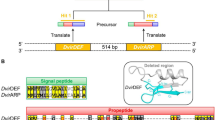Abstract
Drosophila melanogaster is subject to infection by the sigma virus, either by virus carried in the fly gametes or by extracts from infected flies. Infected flies somehow become ‘CO2-sensitive’ and thereafter are fatally poisoned if subjected to a dose of CO2, which is merely anaesthetic to virus-free flies. Plus1 showed that the time lag (incubation period) between a sigma injection and the onset of CO2-sensitivity is a measure of the injected dose, and sigma extracts are now usually titred by using them as inocula and measuring the resultant incubation period in recipient adult flies.
Similar content being viewed by others
References
Plus, N., Bull. Biol., 88, 248 (1954).
Brun, G., Doctoral dissertation, Paris (1963).
Wu, J. H., and Wildman, G., Nature, 199, 1015 (1963).
Burnet, F., Principles of Animal Virology (Academic Press, New York, 1960).
Seecof, R. L., Cold Spring Harb. Symp. Quant. Biol., 27, 501 (1962).
Author information
Authors and Affiliations
Rights and permissions
About this article
Cite this article
SEECOF, R. Resistance to Sigma Virus Infection in Drosophila. Nature 207, 887–888 (1965). https://doi.org/10.1038/207887b0
Issue Date:
DOI: https://doi.org/10.1038/207887b0
- Springer Nature Limited





